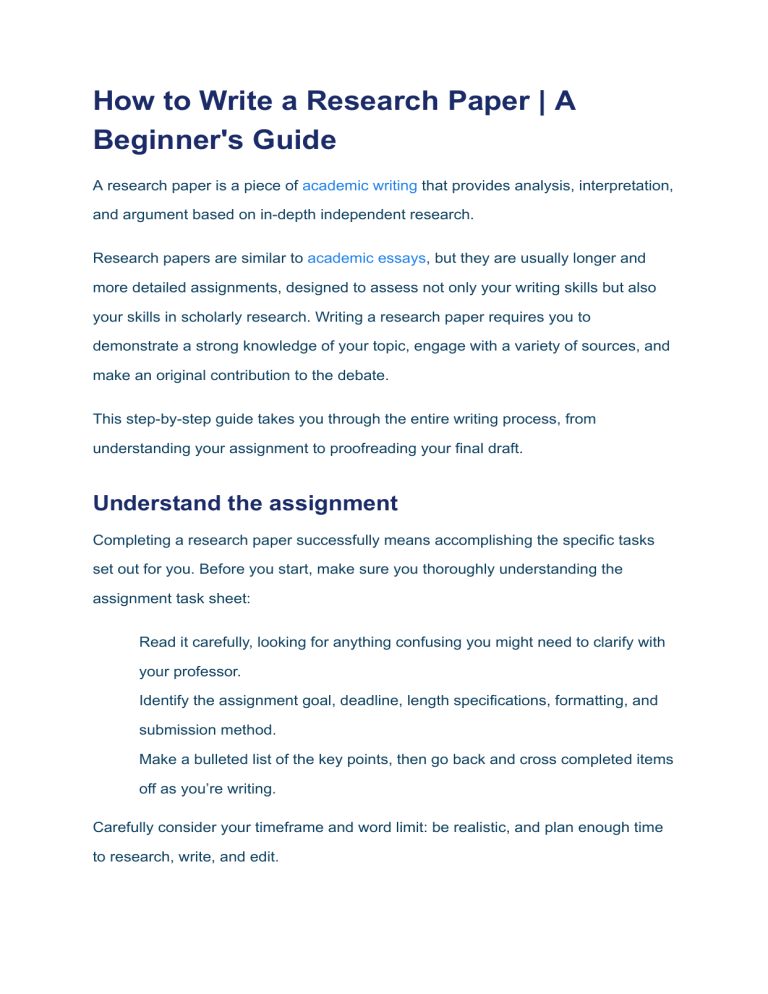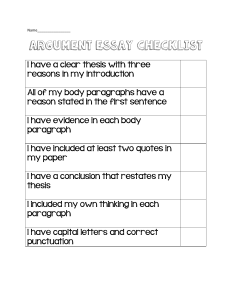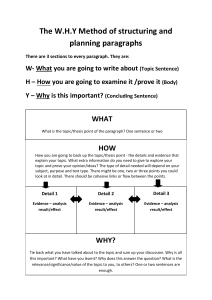
How to Write a Research Paper | A Beginner's Guide A research paper is a piece of academic writing that provides analysis, interpretation, and argument based on in-depth independent research. Research papers are similar to academic essays, but they are usually longer and more detailed assignments, designed to assess not only your writing skills but also your skills in scholarly research. Writing a research paper requires you to demonstrate a strong knowledge of your topic, engage with a variety of sources, and make an original contribution to the debate. This step-by-step guide takes you through the entire writing process, from understanding your assignment to proofreading your final draft. Understand the assignment Completing a research paper successfully means accomplishing the specific tasks set out for you. Before you start, make sure you thoroughly understanding the assignment task sheet: Read it carefully, looking for anything confusing you might need to clarify with your professor. Identify the assignment goal, deadline, length specifications, formatting, and submission method. Make a bulleted list of the key points, then go back and cross completed items off as you’re writing. Carefully consider your timeframe and word limit: be realistic, and plan enough time to research, write, and edit. Scribbr Citation CheckerNew The AI-powered Citation Checker helps you avoid common mistakes such as: Missing commas and periods Incorrect usage of “et al.” Ampersands (&) in narrative citations Missing reference entries Learn more Choose a research paper topic There are many ways to generate an idea for a research paper, from brainstorming with pen and paper to talking it through with a fellow student or professor. You can try free writing, which involves taking a broad topic and writing continuously for two or three minutes to identify absolutely anything relevant that could be interesting. You can also gain inspiration from other research. The discussion or recommendations sections of research papers often include ideas for other specific topics that require further examination. Once you have a broad subject area, narrow it down to choose a topic that interests you, meets the criteria of your assignment, and is possible to research. Aim for ideas that are both original and specific: A paper following the chronology of World War II would not be original or specific enough. A paper on the experience of Danish citizens living close to the German border during World War II would be specific and could be original enough. Conduct preliminary research Note any discussions that seem important to the topic, and try to find an issue that you can focus your paper around. Use a variety of sources, including journals, books, and reliable websites, to ensure you do not miss anything glaring. Do not only verify the ideas you have in mind, but look for sources that contradict your point of view. ● Is there anything people seem to overlook in the sources you research? ● Are there any heated debates you can address? ● Do you have a unique take on your topic? ● Have there been some recent developments that build on the extant research? In this stage, you might find it helpful to formulate some research questions to help guide you. To write research questions, try to finish the following sentence: “I want to know how/what/why…” Develop a thesis statement A thesis statement is a statement of your central argument — it establishes the purpose and position of your paper. If you started with a research question, the thesis statement should answer it. It should also show what evidence and reasoning you’ll use to support that answer. The thesis statement should be concise, contentious, and coherent. That means it should briefly summarize your argument in a sentence or two, make a claim that requires further evidence or analysis, and make a coherent point that relates to every part of the paper. You will probably revise and refine the thesis statement as you do more research, but it can serve as a guide throughout the writing process. Every paragraph should aim to support and develop this central claim. Scribbr Citation CheckerNew The AI-powered Citation Checker helps you avoid common mistakes such as: Missing commas and periods Incorrect usage of “et al.” Ampersands (&) in narrative citations Missing reference entries Learn more Create a research paper outline A research paper outline is essentially a list of the key topics, arguments, and evidence you want to include, divided into sections with headings so that you know roughly what the paper will look like before you start writing. A structure outline can help make the writing process much more efficient, so it’s worth dedicating some time to create one. TipAI tools like ChatGPT can be effectively used to brainstorm potential thesis statements and develop research paper outlines. However, trying to pass off AI-generated text as your own work is widely considered plagiarism. This offense will be recognized by your university’s plagiarism checker or AI detector. Instead, we recommend visiting our AI writing resources page to learn how to use AI tools responsibly. Write a first draft of the research paper Your first draft won’t be perfect — you can polish later on. Your priorities at this stage are as follows: Maintaining forward momentum — write now, perfect later. Paying attention to clear organization and logical ordering of paragraphs and sentences, which will help when you come to the second draft. Expressing your ideas as clearly as possible, so you know what you were trying to say when you come back to the text. You do not need to start by writing the introduction. Begin where it feels most natural for you — some prefer to finish the most difficult sections first, while others choose to start with the easiest part. If you created an outline, use it as a map while you work. Do not delete large sections of text. If you begin to dislike something you have written or find it doesn’t quite fit, move it to a different document, but don’t lose it completely — you never know if it might come in useful later. Paragraph structure Paragraphs are the basic building blocks of research papers. Each one should focus on a single claim or idea that helps to establish the overall argument or purpose of the paper. Here is an example of a well-structured paragraph. Hover over the sentences to learn more. Example paragraph George Orwell’s 1946 essay “Politics and the English Language” has had an enduring impact on thought about the relationship between politics and language.This impact is particularly obvious in light of the various critical review articles that have recently referenced the essay.For example, consider Mark Falcoff’s 2009 article in The National Review Online, “The Perversion of Language; or, Orwell Revisited,” in which he analyzes several common words (“activist,” “civil-rights leader,” “diversity,” and more).Falcoff’s close analysis of the ambiguity built into political language intentionally mirrors Orwell’s own point-by-point analysis of the political language of his day.Even 63 years after its publication, Orwell’s essay is emulated by contemporary thinkers. Citing sources It’s also important to keep track of citations at this stage to avoid accidental plagiarism. Each time you use a source, make sure to take note of where the information came from. You can use our free citation generators to automatically create citations and save your reference list as you go. APA Citation Generator MLA Citation Generator Write the introduction The research paper introduction should address three questions: What, why, and how? After finishing the introduction, the reader should know what the paper is about, why it is worth reading, and how you’ll build your arguments. What? Be specific about the topic of the paper, introduce the background, and define key terms or concepts. Why? This is the most important, but also the most difficult, part of the introduction. Try to provide brief answers to the following questions: What new material or insight are you offering? What important issues does your essay help define or answer? How? To let the reader know what to expect from the rest of the paper, the introduction should include a “map” of what will be discussed, briefly presenting the key elements of the paper in chronological order. Write a compelling body of text The major struggle faced by most writers is how to organize the information presented in the paper, which is one reason an outline is so useful. However, remember that the outline is only a guide and, when writing, you can be flexible with the order in which the information and arguments are presented. One way to stay on track is to use your thesis statement and topic sentences. Check: topic sentences against the thesis statement; topic sentences against each other, for similarities and logical ordering; and each sentence against the topic sentence of that paragraph. Be aware of paragraphs that seem to cover the same things. If two paragraphs discuss something similar, they must approach that topic in different ways. Aim to create smooth transitions between sentences, paragraphs, and sections. Write the conclusion The research paper conclusion is designed to help your reader out of the paper’s argument, giving them a sense of finality. Trace the course of the paper, emphasizing how it all comes together to prove your thesis statement. Give the paper a sense of finality by making sure the reader understands how you’ve settled the issues raised in the introduction. You might also discuss the more general consequences of the argument, outline what the paper offers to future students of the topic, and suggest any questions the paper’s argument raises but cannot or does not try to answer. You should not: Offer new arguments or essential information Take up any more space than necessary Begin with stock phrases that signal you are ending the paper (e.g. “In conclusion”) The second draft There are four main considerations when it comes to the second draft. 1. Check how your vision of the paper lines up with the first draft and, more importantly, that your paper still answers the assignment. 2. Identify any assumptions that might require (more substantial) justification, keeping your reader’s perspective foremost in mind. Remove these points if you cannot substantiate them further. 3. Be open to rearranging your ideas. Check whether any sections feel out of place and whether your ideas could be better organized. 4. If you find that old ideas do not fit as well as you anticipated, you should cut them out or condense them. You might also find that new and well-suited ideas occurred to you during the writing of the first draft — now is the time to make them part of the paper. The revision process The goal during the revision and proofreading process is to ensure you have completed all the necessary tasks and that the paper is as well-articulated as possible. Global concerns Confirm that your paper completes every task specified in your assignment sheet. Check for logical organization and flow of paragraphs. Check paragraphs against the introduction and thesis statement. Fine-grained details Check the content of each paragraph, making sure that: each sentence helps support the topic sentence. no unnecessary or irrelevant information is present. all technical terms your audience might not know are identified. Next, think about sentence structure, grammatical errors, and formatting. Check that you have correctly used transition words and phrases to show the connections between your ideas. Look for typos, cut unnecessary words, and check for consistency in aspects such as heading formatting and spellings. Tip: Create better flowing sentences with a paraphrasing tool. Finally, you need to make sure your paper is correctly formatted according to the rules of the citation style you are using. For example, you might need to include an MLA heading or create an APA title page.



